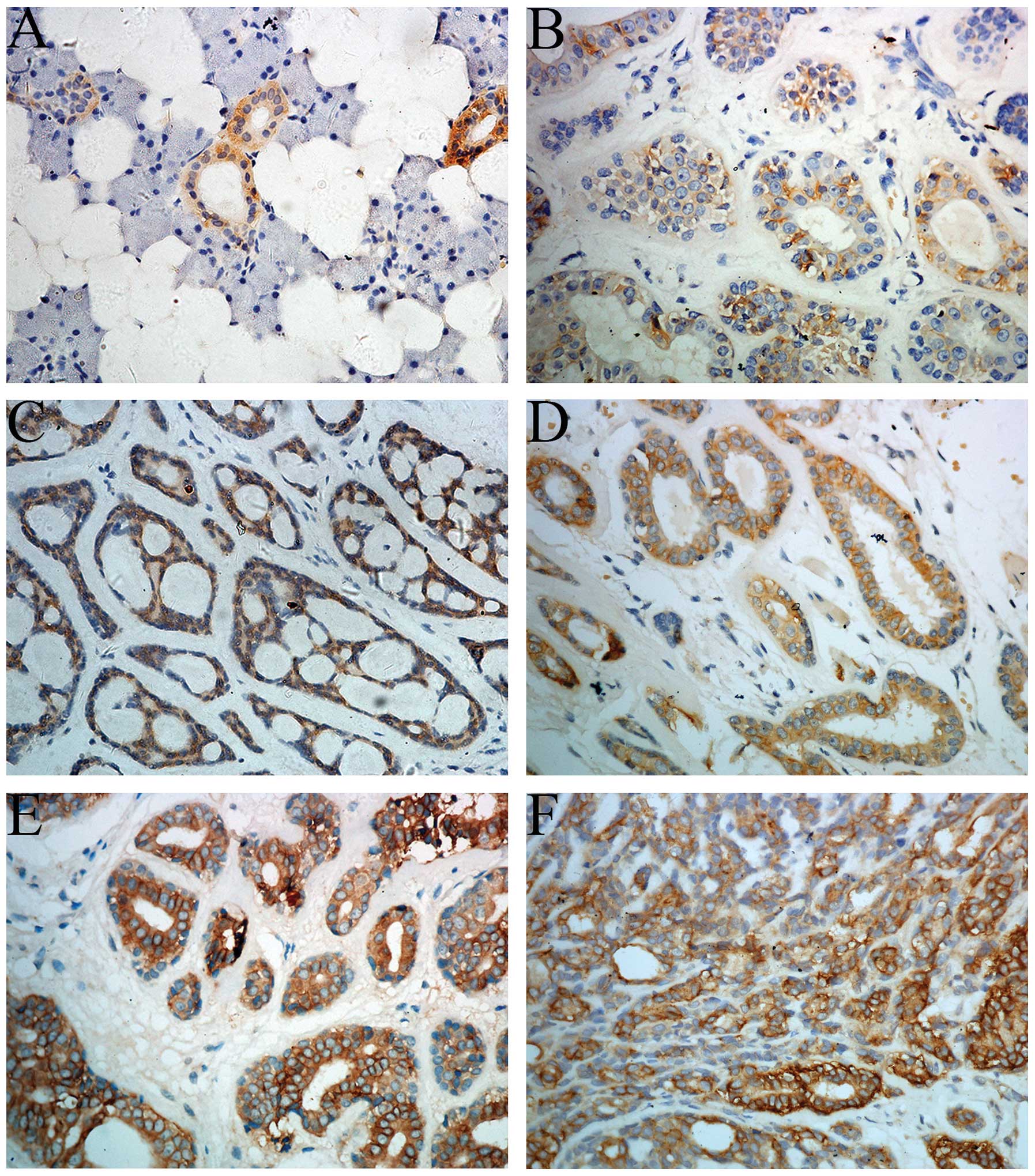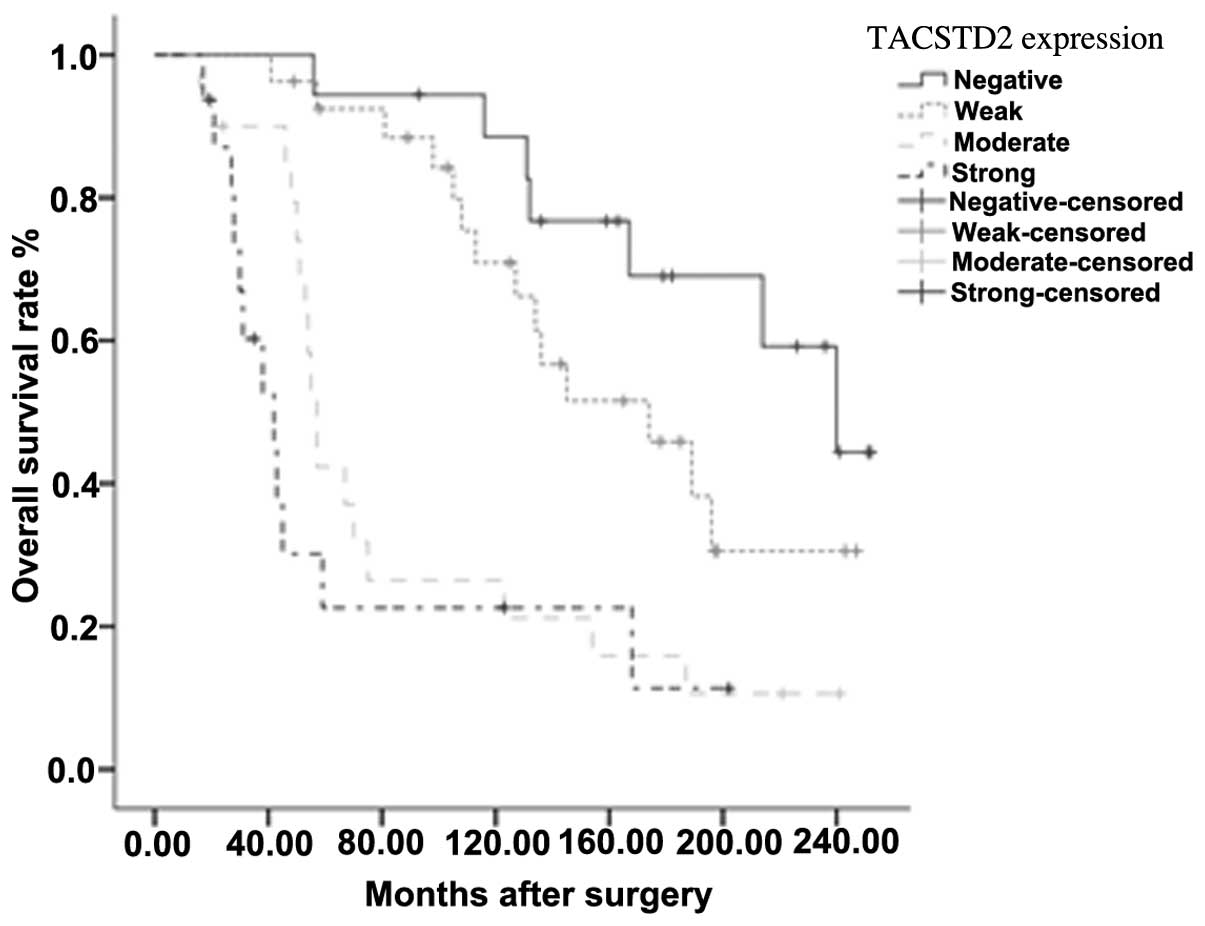|
1
|
Li LJ, Li Y, Wen YM, et al: Clinical
analysis of salivary gland tumor cases in West China in past 50
years. Oral Oncol. 44:187–192. 2008.
|
|
2
|
Spiro RH: Salivary neoplasms: overview of
a 35-year experience with 2,807 patients. Head Neck Surg.
8:177–184. 1986.
|
|
3
|
Gao M, Hao Y, Huang MX, et al:
Clinicopathological study of distant metastases of salivary adenoid
cystic carcinoma. Int J Oral Maxillofac Surg. 42:923–928. 2013.
|
|
4
|
Trzpis M, McLaughlin PM, de Leij LM and
Harmsen MC: Epithelial cell adhesion molecule: more than a
carcinoma marker and adhesion molecule. Am J Pathol. 171:386–395.
2007.
|
|
5
|
Ripani E, Sacchetti A, Corda D and Alberti
S: Human Trop-2 is a tumor-associated calcium signal transducer.
Int J Cancer. 76:671–676. 1998.
|
|
6
|
Lipinski M, Parks DR, Rouse RV and
Herzenberg LA: Human trophoblast cell-surface antigens defined by
monoclonal antibodies. Proc Natl Acad Sci USA. 78:5147–5150.
1981.
|
|
7
|
Linnenbach AJ, Wojcierowski J, Wu SA, et
al: Sequence investigation of the major gastrointestinal
tumor-associated antigen gene family, GA733. Proc Natl Acad Sci
USA. 86:27–31. 1989.
|
|
8
|
Guerra E, Trerotola M, Aloisi AL, et al:
The Trop-2 signalling network in cancer growth. Oncogene.
32:1594–1600. 2013.
|
|
9
|
El Sewedy T, Fornaro M and Alberti S:
Cloning of the murine TROP2 gene: conservation of a PIP2-binding
sequence in the cytoplasmic domain of TROP-2. Int J Cancer.
75:324–330. 1998.
|
|
10
|
Wang J, Day R, Dong Y, et al:
Identification of Trop-2 as an oncogene and an attractive
therapeutic target in colon cancers. Mol Cancer Ther. 7:280–285.
2008.
|
|
11
|
Fong D, Spizzo G, Gostner JM, et al:
TROP2: a novel prognostic marker in squamous cell carcinoma of the
oral cavity. Mod Pathol. 21:186–191. 2008.
|
|
12
|
Fong D, Moser P, Krammel C, et al: High
expression of TROP2 correlates with poor prognosis in pancreatic
cancer. Br J Cancer. 99:1290–1295. 2008.
|
|
13
|
Liu T, Liu Y, Bao X, et al: Overexpression
of TROP2 predicts poor prognosis of patients with cervical cancer
and promotes the proliferation and invasion of cervical cancer
cells by regulating ERK signaling pathway. PloS One.
8:e758642013.
|
|
14
|
Ning S, Guo S, Xie J, Xu Y, Lu X and Chen
Y: TROP2 correlates with microvessel density and poor prognosis in
hilar cholangiocarcinoma. J Gastrointest Surg. 17:360–368.
2013.
|
|
15
|
Mühlmann G, Spizzo G, Gostner J, et al:
TROP2 expression as prognostic marker for gastric carcinoma. J Clin
Pathol. 62:152–158. 2009.
|
|
16
|
Bignotti E, Todeschini P, Calza S, et al:
Trop-2 overexpression as an independent marker for poor overall
survival in ovarian carcinoma patients. Eur J Cancer. 46:944–953.
2010.
|
|
17
|
da Cruz Perez DE, de Abreu Alves F, Nobuko
Nishimoto I, et al: Prognostic factors in head and neck adenoid
cystic carcinoma. Oral Oncol. 42:139–146. 2006.
|
|
18
|
Seifert G and Sobin LH: The World Health
Organization’s Histological Classification of Salivary Gland
Tumors. A commentary on the second edition. Cancer. 70:379–385.
1992.
|
|
19
|
Linnenbach AJ, Seng BA, Wu S, et al:
Retroposition in a family of carcinoma-associated antigen genes.
Mol Cell Biol. 13:1507–1515. 1993.
|
|
20
|
Nakashima K, Shimada H, Ochiai T, et al:
Serological identification of TROP2 by recombinant cDNA expression
cloning using sera of patients with esophageal squamous cell
carcinoma. Int J Cancer. 112:1029–1035. 2004.
|
|
21
|
Guerra E, Trerotola M, Dell’ Arciprete R,
et al: A bicistronic CYCLIN D1-TROP2 mRNA chimera demonstrates a
novel oncogenic mechanism in human cancer. Cancer Res.
68:8113–8121. 2008.
|
|
22
|
Cubas R, Zhang S, Li M, Chen C and Yao Q:
Trop2 expression contributes to tumor pathogenesis by activating
the ERK MAPK pathway. Mol Cancer. 9:2532010.
|
|
23
|
Biliran H Jr, Wang Y, Banerjee S, et al:
Overexpression of cyclin D1 promotes tumor cell growth and confers
resistance to cisplatin-mediated apoptosis in an elastase-myc
transgene-expressing pancreatic tumor cell line. Clin Cancer Res.
11:6075–6086. 2005.
|
|
24
|
Trerotola M, Li J, Alberti S and Languino
LR: Trop-2 inhibits prostate cancer cell adhesion to fibronectin
through the β1 integrin-RACK1 axis. J Cell Physiol. 227:3670–3677.
2012.
|
|
25
|
Trerotola M, Jernigan DL, Liu Q, et al:
Trop-2 promotes prostate cancer metastasis by modulating β(1)
integrin functions. Cancer Res. 73:3155–3167. 2013.
|
|
26
|
de Bono JS, Tolcher AW, Forero A, et al:
ING-1, a monoclonal antibody targeting Ep-CAM in patients with
advanced adenocarcinomas. Clin Cancer Res. 10:7555–7565. 2004.
|
|
27
|
Mosolits S, Markovic K, Frodin JE, et al:
Vaccination with Ep-CAM protein or anti-idiotypic antibody induces
Th1-biased response against MHC class I- and II-restricted Ep-CAM
epitopes in colorectal carcinoma patients. Clin Cancer Res.
10:5391–5402. 2004.
|
|
28
|
Bignotti E, Ravaggi A, Romani C, et al:
Trop-2 overexpression in poorly differentiated endometrial
endometrioid carcinoma: implications for immunotherapy with hRS7, a
humanized anti-trop-2 monoclonal antibody. Int J Gynecol Cancer.
21:1613–1621. 2011.
|
|
29
|
Raji R, Guzzo F, Carrara L, et al: Uterine
and ovarian carcinosarcomas overexpressing Trop-2 are sensitive to
hRS7, a humanized anti-Trop-2 antibody. J Exp Clin Cancer Res.
30:1062011.
|
|
30
|
Varughese J, Cocco E, Bellone S, et al:
Uterine serous papillary carcinomas overexpress human
trophoblast-cell-surface marker (Trop-2) and are highly sensitive
to immunotherapy with hRS7, a humanized anti-Trop-2 monoclonal
antibody. Cancer. 117:3163–3172. 2011.
|
|
31
|
Govindan SV, Stein R, Qu Z, et al:
Preclinical therapy of breast cancer with a radioiodinated
humanized anti-EGP-1 monoclonal antibody: advantage of a
residualizing iodine radiolabel. Breast Cancer Res Treat.
84:173–182. 2004.
|
|
32
|
Lin H, Zhang H, Wang J, et al: A novel
human Fab antibody for Trop2 inhibits breast cancer growth in vitro
and in vivo. Int J Cancer. 34:1239–1249. 2014.
|
















